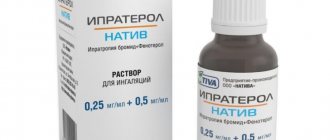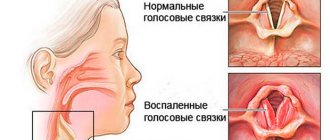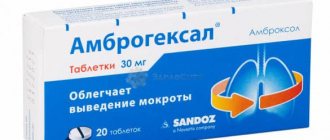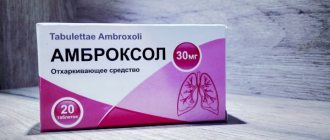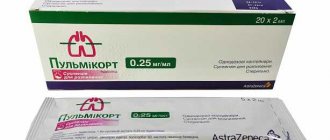Budesonide is a hormone with strong anti-inflammatory and antiallergic effects. It is prescribed for the primary treatment of bronchial asthma, helping to prevent attacks, but does not relieve them directly.
There are several dosage forms (tablets, nasal spray, aerosol in a can), but nebulas are suitable for the nebulizer - plastic containers Pulmicort, Budesonide-native, Budenit steri-neb. Available in two dosages - 0.25 and 0.5 mcg/ml. For one procedure, children need 0.25-0.5 mcg, and for adults – 1-2 mcg.
The drug is contraindicated for tuberculosis, fungal infection, and lactation. Caution and medical supervision are necessary when treating children, pregnant women, with concomitant diseases of the kidneys, blood vessels, and hormonal pathologies.
Main characteristics of Budesonide
Budesonide is a glucocorticosteroid hormone, that is, an analogue of cortisol produced by the adrenal cortex. It is important to consider that this is the name of the drug - Budesonide aerosol, as well as the main component of a number of medications (for example, Pulmicort, Tafen), it is part of combination drugs (Symbicort, Formisonide). The characteristics are shown in the table.
| Sign | Properties of Budesonide (active substance) |
| What it is | Hormonal drug |
| Pharmacological group | Glucocorticosteroids |
| Compound | Powder, finely ground in various release forms |
| Mechanism of action | Inhibits the release of compounds that cause inflammation and allergies |
| Effect on the bronchi | Anti-inflammatory, antiallergic, decongestant, reduces sputum formation, reduces reaction to allergen, prevents bronchospasm |
| The result of treatment of bronchitis and asthma | Less shortness of breath and cough, less frequent and easier attacks of suffocation |
| When the result appears | In 1-2 weeks |
| Effect on the intestines | Reduces inflammation in ulcerative colitis |
| Advantages compared to Prednisolone | Stronger, but much less suppressive of adrenal function |
Preparations with budesonide
This hormonal drug is available in various release forms and trade names (see table).
| Release form | Tradename | Price, rubles |
| Capsules | Budenofalk 2 mg No. 20 | 1510 |
| Pills | Cortiment 9 mg No. 30 | 10120 |
| Granulated powder in bags | Budenofalk 9 mg No. 20 | 4400 |
| Rectal foam with applicators | Budenofalk 14 doses | 5320 |
| Aerosol for bronchi (powder for inhalation) | Budesonide easyhaler 200 mcg 200 doses | 1020 |
| Pulmicort 100 mcg 200 doses | 770 | |
| Suspension for inhalation (budesonide in nebulas) | Budesonide-native 0.5 mg/ml 2ml No. 10 (Budesonide 500 mcg for inhalation) | 380 |
| Budenit steri-neb 0.5 mg/ml 2ml No. 60 | 2200 | |
| Pulmicort 0.5 mg/ml 2 ml No. 20 | 1200 | |
| Nasal spray | Tafen nasal 50 mcg per dose, 200 doses | 360 |
| Budoster 100 mcg per dose, 200 doses | 600 | |
| Nasal drops | Benacap 0.05%, 5 ml | 340 |
There are currently no registered ointment formulations and no trade names for the combination of salmeterol and budesonide, but they can be purchased separately (eg Serevent and Pulmicort).
Recipe in Latin
When purchasing budesonide, a prescription in Latin is required. Example for aerosols:
Rp.: Aer. Budesonidi 200 mkg D. td No. 1
S.: 2 inhalations 2 times a day.
Release form
The drug is available in the form of a homogeneous powder for inhalation, the color of which can vary from white to almost white. Each dose of powder contains 200 mcg of budesonide. One package of Budesonide is designed for 200 doses.
Each package of the drug is equipped with an inhaler made of polymer material. The dosing part has a lid with a lock, the inscription “Easyhaler” is printed on the front part, and a counter for the remaining doses of the drug is provided on the side.
Budesonide for inhalation: instructions for use
According to the instructions, Budesonide native is intended for inhalation through a compressor-type nebulizer and MESH. The form of Budesonide Inteli (pocket metered dose aerosol) is used for patients with low inspiratory force, as the powder is nebulized under pressure. Dosages and treatment regimens are determined and monitored by a doctor, most often 0.25-0.5 mg per day is needed for children, and 1-2 mg for adults with nebulizer therapy.
Indications for use
The main indication for the use of Budesonide in aerosol form (a can or via a nebulizer) is bronchial asthma or obstructive pulmonary disease requiring treatment with hormones. This therapy is considered basic because it:
- helps reduce the frequency of attacks;
- allows you to reduce the dose of hormonal pills that cause serious side effects;
- can slow down the progression of the disease and avoid complications.
Hormones are not always required for asthma with rare attacks and long periods of remission (improvement). It is important to consider that Budesonide cannot relieve suffocation; for this, drugs from the group of bronchodilators (Berodual, Serevent, Salbutamol and others) are used.
For internal use (tablets, capsules, packets), as well as for administration into the rectum, the drug is prescribed for nonspecific ulcerative colitis or allergic, autoimmune inflammation of the intestine.
Spray and nasal drops are used for:
- allergic rhinitis (seasonal, year-round);
- after removal of polyps to prevent the growth of new ones;
- inflammatory lesions of the nasal passages (non-infectious).
Budesonide-native and Budesonide-Inteli: what and when to use
Budesonide native is available in the form of a suspension for inhalation via a nebulizer, and Budesonide Inteli is a pocket-sized metered dose inhaler with a spray of medication under pressure. The first drug (nebula) is intended for administration into the respiratory tract through a compressor-type inhaler or MESH. The ultrasound device destroys hormones, so it is not suitable for treatment. Nebulizer therapy has the following advantages:
- you can choose an individual dose;
- easy to use, no need to adjust the inhalation to the flow of the drug;
- additional humidification of the respiratory tract occurs;
- The MESH nebulizer is pocket-sized, you can easily take it with you, and also administer other medications through it.
Budesonide Inteli differs in that the aerosol is sprayed under pressure. This allows the inhaler to be used for children, the elderly and weakened people. These categories of patients often cannot receive the required dose with conventional drugs, since they have weak inspiratory power. Because of this, the main part settles in the upper respiratory tract, causing fungal infections of the mucous membranes, and the medicine partially passes into the bronchi.
Therefore, Budesonide Intel facilitates treatment, regardless of the causes of respiratory failure.
How to prepare a solution for inhalation
The solution for inhalation through a nebulizer is prepared as follows:
- Fill a syringe with saline solution and heat it to 40 degrees (dip it into a container with water at the appropriate temperature).
- Open the container with the medication and squeeze the contents into the nebulizer container.
- Add warm saline solution to Budesonide.
- Assemble the apparatus and turn on the spray.
Each time the solution is prepared anew. After opening the nebula and mixing it with saline, the medicine is stored for no more than 30 minutes, after which it can no longer be used. If there is a remainder of the drug in the container (undiluted), then it is suitable for inhalation for 12 hours.
Dosage for nebulizer for children and adults
When determining the dosage of budesonide for nebulizer for children and adult patients, the severity of asthma, age and treatment regimen are taken into account (see table).
| Age | Minimum dose | Maximum dose | Volume of saline solution | Number of procedures per day |
| 6 months - 12 years | 0.25 mcg | 0.5 mcg | 2 ml | 1 |
| 12 years – 18 years | 0.5 mcg | 0.75 mcg | 1 ml | 1 |
| From 18 years and older | 1 mcg | 2 mcg | Up to 2 ml total | 1 with the introduction of 1 mcg, and 2 mcg is divided into 2 times |
These dosages are reviewed after 1 week of use of the drug. If patients continue to have asthma attacks, the doctor may increase them. After the condition has stabilized, an individual maintenance dose is selected.
If inhalations are prescribed to a patient who takes hormones in tablets, then for 10 days Budesonide only complements the treatment. Then they begin to gradually reduce the amount of hormonal drugs for internal use and replace them with inhalation of an aerosol.
How to do inhalations
To do inhalation, you need:
- Heat the saline solution.
- Make sure that the dose of Budesonide is correct (one nebula may contain 25 or 50 mg of the drug, depending on the form of release).
- Fill the nebulizer liquid container.
- Assemble the device.
- Place a mask on your face or use a mouthpiece.
- Turn on spraying.
- Breathe smoothly and calmly until the aerosol flows.
- Turn off the device.
- Remove the mask and disassemble all removable tubes and liquid container.
- Rinse your mouth, wash your face.
- Rinse the nebulizer parts with water and leave to dry.
- Avoid eating, drinking liquids, talking, exercising, smoking for an hour
Features of the use of Budesonide for inhalation for children
To carry out Budesonide inhalations for children, it is very important to correctly measure the dose of the solution depending on the form of the drug (see table).
| Budesonide dose | Nebulas 0.25 µg/ml | Nebulas 0.5 mcg/ml | Saline solution |
| 0.25 mcg | 1 ml | 0.5 ml | 2 ml |
| 0.5 mcg | 2 ml | 1 ml | 1 ml |
| 0.75 mcg | 3 ml | 1.5 ml | Up to 2 ml |
| 1 mcg | 4 ml | 2 ml | Not needed |
In case of false croup (an attack of suffocation due to a spasm of the larynx during ARVI) or a severe course, the daily dose for a child can be increased to 2 mcg. In this case, 2 procedures of 1 mcg or simultaneous administration of 4 ml at a concentration of 0.5 mcg/ml are recommended, since most nebulizers are designed for a maximum volume of 7 ml of solution.
Inhalation in a child is always carried out in the presence of an adult; he controls the tightness of the mask, smooth and uniform breathing and general condition.
At the end of the procedure, it is necessary to rinse the mouth with clean water and thoroughly wash the face, since hormone residues in children cause skin irritation and fungal diseases.
Side effects
When Budesonide is administered into the respiratory tract (inhalation with a nebulizer, spray can), the following adverse reactions occur:
- irritation of the nasal passages (sneezing, burning), oral cavity (unpleasant sensations, dryness), pharynx (stingling, pain when swallowing), larynx (hoarseness);
- fungal infections of the mucous membranes (thrush);
- reflex spasm of the bronchi (cough, difficulty breathing).
The mechanism of systemic bioavailability of the drug
Although Budesonide is considered less dangerous in terms of general (systemic) reactions than, for example, Dexamethasone, when inhaled, about a third of the administered hormone passes into the blood. Therefore, complications are possible, especially with long-term use or large doses:
- skin redness;
- pink stretch marks;
- acne;
- spider veins;
- prolonged wound healing;
- easy bruising;
- accelerated bone destruction;
- tendency to fractures of the femoral neck and near the wrist joint;
- increased intraocular pressure;
- cataract;
- irritability, excitability (especially in children), insomnia;
- depression, less often euphoria;
- abdominal pain, nausea, urge to vomit;
- peptic ulcer, exacerbation of pancreatitis (inflammation of the pancreas);
- dysfunction of the adrenal glands - high or low blood pressure, fat deposition in the upper half of the body, abdomen, face, diabetes mellitus (thirst, frequent urination, increased appetite, weight fluctuations);
- hormonal imbalance (failure) of sex steroids - changes in the rhythm of menstruation, sexual weakness, hair growth on the body and face in women;
- swelling;
- convulsive muscle twitching;
- blood thickening and the formation of blood clots in blood vessels;
- frequent colds, exacerbation of infections, inflammation due to decreased immune defense;
- growth retardation in children.
Watch this video about the mechanism of action, indications for the drug Budesonide and its side effects:
Is it possible during pregnancy and breastfeeding?
If during pregnancy it is impossible to get rid of attacks of bronchial asthma without hormones, then Budesonide in the form of inhalations is prescribed under the supervision of a doctor. It is important to monitor the newborn in the future, as he often has low adrenal function.
Women of childbearing age are advised to carefully protect themselves if hormonal therapy is necessary, since it is still considered dangerous for the development of the fetus. Internal use (tablets, capsules) is strictly prohibited. Budesonide is contraindicated during breastfeeding because it cannot be excluded from passing into milk. The child is transferred to artificial milk formula.
Precautionary measures
The hormonal drug Budesonide is used with caution (continuous medical supervision) when:
- viral infection - influenza, herpes, chicken pox and others;
- tuberculosis (inactive form);
- under 7 years of age and after 60;
- dysfunction of the liver, kidneys, adrenal glands;
- diabetes mellitus;
- high blood pressure;
- glaucoma, cataracts;
- diseases of the stomach, intestines;
- mental disorders and hereditary predisposition to them.
It is forbidden to change the dose of the hormone or stop treatment on your own. The question of replacing Budesonide with another hormonal drug is discussed with your doctor. In order to minimize the risk of adverse reactions, you need to:
- use the lowest doses;
- eliminate risk factors for exacerbations - smoking, contact with allergens, including food;
- use bronchodilators before inhalation with hormones, this will help Budesonide penetrate deeply;
- do not use other medications without recommendation, since their interaction is not always favorable;
- If any unusual symptom appears, immediately contact your doctor;
- take blood tests for adrenal hormones, sugar, electrolytes, feces for occult blood throughout the course;
- assess the growth rate of children;
- check lung function, bone condition;
- visit an ophthalmologist at least once every three months;
- measure blood pressure daily.
Contraindications to micronized preparation
Budesonide in the form of a microionized inhalation suspension is contraindicated in:
- individual intolerance;
- lactation;
- active form of pulmonary tuberculosis;
- fungal diseases of the respiratory tract.
For tuberculosis infection and fungal infections, in some cases it is possible to use the drug in combination with antimicrobial or antifungal agents. Low doses of Budesonide up to 0.5 mcg/day when administered via a nebulizer in a short course are allowed for nursing mothers.
Interaction with other drugs
The simultaneous use of drugs should be avoided:
- antifungal action (ketoconazole, itraconazole);
- for the treatment of HIV (ritonavir, indinavir and analogues of action);
- antibiotics – Erythromycin, Klacid;
- anti-ulcer – Cimetidine.
All of them interfere with the neutralization of budesonide in the liver, which means they increase the risk of complications of hormonal therapy. If they cannot be replaced, then you need to take a maximum break between inhalation and taking these medications.
When consuming alcohol or anti-clotting drugs (for example, Warfarin), the risk of bleeding increases, including cerebral hemorrhage (hemorrhagic stroke). Antidepressants are prohibited, as they increase the possibility of severe mental disorders during hormonal therapy.
It is dangerous to vaccinate or take antitumor drugs due to decreased immunity. Hormonal birth control pills slow down the elimination of budesonide, which requires a dosage reduction.
Overdose
In case of an overdose, signs of excess steroid hormones appear:
- hair growth on the face and body in women;
- stretch marks on the skin;
- fat deposition on the face and torso;
- increased blood pressure;
- acne;
- swelling.
Treatment requires a dose reduction under the supervision of a physician.
We recommend reading the article about the drug Pulmicort for inhalation. From it you will learn about the main characteristics of the inhalation drug Pulmicort, how to breathe Pulmicort through a nebulizer, as well as the side effects of the drug and its analogues. And here is more information about the benefits of the Omron nebulizer.
Pharmacodynamics and pharmacokinetics
Budesonide belongs to the category of non-halogenated glucocorticosteroids . When applied topically, it relieves symptoms of inflammation of the mucous membrane of the respiratory tract .
Improvement in the condition of patients suffering from bronchial asthma can be observed within 24 hours after the first inhalation of the drug. However, several weeks of continuous therapy are required to achieve maximum effect.
The mechanism of the effect of glucocorticosteroids on the inflammatory process in bronchial asthma has not been precisely studied. Studies have shown that budesonide provokes a number of inhibitory effects on cells (including eosinophil granulocytes , lymphocytes , macrophagocytes , mast cells and neutrophil granulocytes ), as well as on mediators that are involved in the development of allergic and non-allergic airway inflammation cytokines , leukotrienes , eicosanoids and histamine ).
Budesonide has pronounced glucocorticoid and weakly expressed mineralocorticoid activity. Standard in vitro studies, as well as studies conducted on experimental animals, have led to the conclusion that the affinity (affinity) of the substance for specific glucocorticoid is 200 times higher than that of cortisol .
As for the local anti-inflammatory effect of budesonide, it is a thousand times greater than the anti-inflammatory effect of cortisol . Animal studies have also shown that the systemic activity of budesonide when administered subcutaneously exceeds the systemic activity of cortisol by 40 times, and when administered orally by 25 times.
Once in the body, budesonide:
- increases the production of lipocortin , which is an inhibitor of the enzyme activity of phospholipase A2;
- inhibits the release of arachidonic acid and suppresses the synthesis of its metabolic products ( prostaglandins and cyclic endoperoxides );
- prevents the marginal accumulation of neutrophilic granulocytes ;
- inhibits the exudation of fluid and protein into the site of inflammation;
- reduces the production of cytokines ;
- inhibits the migration of macrophagocytes ;
- helps reduce the intensity of infiltration and granulation processes;
- reduces the intensity of the formation of a chemotaxis substance, that is, the migration of leukocytes to the site of inflammation (it is this property that explains the effectiveness of budesonide in so-called “late” allergy );
- prevents the release of mediators of the inflammatory process from highly specialized immune cells of connective tissue involved in adaptive immunity (the so-called mast cells );
- reduces the sensitivity of peripheral tissues to histamine and serotonin , while simultaneously increasing sensitivity to adrenaline ;
- increases the number of active beta-adrenergic receptors;
- helps restore the body's response to beta-adrenergic bronchodilators after prolonged treatment with them;
- reduces the permeability of tissue barriers and vascular walls;
- inhibits the proliferation of connective tissue at the site of inflammation;
- helps stabilize cell membranes;
- prevents the formation of free radicals and inhibits the processes of oxidative degradation of lipids under their influence.
At the same time, the substance is well tolerated (even with long-term use), does not have MCS activity and does not provoke resorptive effects.
Budesonide is characterized by the ability to be rapidly absorbed from the lungs , stomach and intestinal tract , which is determined by its pronounced lipophilic properties and good tissue permeability.
After administration into the nasal cavity, it is absorbed in very small quantities from the mucous membrane of the nasal cavity (only a fifth of the substance penetrates the systemic bloodstream ).
After using budesonide for inhalation, approximately a quarter of a single dose of the substance the alveoli
About 90% of the budesonide dose that enters the stomach and intestinal tract cytochrome P450 enzyme system already during the “first pass” through the liver , which is accompanied by the formation of two main inactive metabolites (their activity is less than 0.01 of the activity of the original substance).
Budesonide is metabolized in small amounts in the blood serum and in the lungs . The bioavailability of the substance entering the stomach and intestines is 10%. As for budesonide in the alveoli , approximately 25 to 30% of the amount is absorbed.
The maximum concentration of the drug in the blood plasma is observed approximately 15-45 minutes after the inhalation procedure or administration of the drug into the nasal cavity .
The binding rate of budesonide to plasma proteins albumin is 85-95%. Systemic clearance of the drug, that is, the volume of plasma cleared of it over a certain period of time when passing through the kidneys , is estimated to be very high (84 liters per hour).
The half-life (half-life) is just under three hours (approximately 2.8 hours). The substance is excreted mainly in urine and feces in the form of conjugated and unconjugated metabolites (partly together with bile in the form of metabolites).
plasma half-life in children is generally an order of magnitude lower than in adult patients. In adult patients with liver pathologies, the bioavailability of budesonide may increase.
After oral administration, the highest plasma concentration Cmax and the time to reach the maximum concentration after dosing Tmax may vary. Thus, the Tmax indicator in different categories of patients can range from 30 to 600 minutes.
The systemic availability of the substance after a single dose is also characterized by variability: for example, in patients diagnosed with granulomatous enteritis ( Crohn's disease ), it is more than twice as high as in a group of healthy volunteers.
Thus, in patients with granulomatous enteritis it is 21%, and in healthy volunteers it is only 9%. However, after taking repeated doses of budesonide in those studied from the second group, it approaches the value of the indicator in the first group.
Budesonide analogs
Budesonide for inhalation in nebulas is available under the trade names Pulmicort, Budenit and Budesonide-native. Of these, the cheapest analogue is the last drug, since for 20 nebulas you need to pay 300-350 rubles. Among hormonal drugs for inhalation therapy, there are several similar in action (see table), but the question of replacing them is decided only by a doctor.
| Name | Active substance | Price |
| Beclazon Eco | beclomethasone | 200 |
| Beclomethasone | beclomethasone | 172 |
| Flixotide | fluticasone | 600 |
| Alvesco | ciclesonide | 1100 |
Budesonide is considered a strong drug for hormonal therapy of bronchial asthma. Used in the form of a metered aerosol and in nebulas for spraying through a nebulizer. Throughout the course of treatment, you should visit a doctor and undergo tests to reduce the risk of complications. Use with caution in children and pregnancy.
Similar articles
- Pulmicort for inhalation: dosage, features...
How to properly use Pulmicort for inhalation, what doses and course duration for adults and children. How to dilute with saline, breathe correctly with a nebulizer. What is included in the composition, analogues of the drug. Indications and possible harm to the child. Read more - Is it possible to do inhalations at the temperature and at what...
What do doctors think about whether inhalations can be done at a temperature and what temperature it is - 37, 37.5, 38, why not. What drugs can be inhaled for adults and children - Pulmicort, saline solution, Lazolvan. How you can do inhalations - a nebulizer, an ultrasonic inhaler, MESH. Read more
- Nebulizer Omron: which one to choose for an adult...
How to use the Omron nebulizer correctly. Which model is better to choose - C20 or C24, compression, ultrasonic or membrane, portable or battery-powered. How the inhaler works, how to assemble it. Can all medications be filled into the Omron nebulizer? Read more
Contraindications
Contraindications to the use of the drug are:
- individual hypersensitivity to budesonide;
- child's age up to six years ;
- lactose intolerance lactose as an auxiliary ingredient ).
Budesonide should be prescribed with caution to patients with:
- pulmonary tuberculosis;
- liver cirrhosis;
- respiratory infections of fungal, bacterial and viral origin;
- glaucoma;
- hypothyroidism;
- osteoporosis.
Side effects
Treatment with inhaled Budesonide in some cases can cause the development of candidiasis infection of the oropharynx . Experience with the use of the drug shows that symptoms of candidiasis occur much less frequently if the inhalation procedure is carried out before meals, and after it, the oral cavity is thoroughly rinsed.
If it is still not possible to avoid candidal infection , it is not necessary to stop treatment with inhalations, but the patient is additionally prescribed effective against strains of Candida spp. local antifungal drugs .
Like most other glucocorticosteroids for inhalation use, Budesonide can provoke the development of systemic adverse reactions, including:
- disruption of normal activity of the adrenal glands ;
- decreased growth rates in pediatric and adolescent patients;
- decreased bone mineral density;
- development of cataracts and glaucoma ;
- increased susceptibility to various types of infectious diseases;
- impaired ability to adapt to stressful situations.
However, it should be noted that the likelihood of such adverse reactions occurring when taking the drug in the form of inhalations is much lower than for drugs intended for oral administration.
The excipient of Budesonide Easyhaler is lactose , which contains a small amount of milk proteins and can cause allergic reactions in patients intolerant to it.
Possible negative consequences of taking Budesonide are distributed according to the frequency of their development. The most common reactions include hoarseness, cough, symptoms of irritation in the oropharynx, and difficulty swallowing.
Rarely, hypersensitivity reactions may occur, including skin rashes, contact dermatitis, urticaria, angioedema and anaphylactic shock.
The endocrine system in rare cases reacts to budesonide with hypo- or hypercortisolism , that is, respectively, a decrease or increase in the production of adrenal hormones . In extremely rare cases, adrenal .
Also, the possibility of developing mental reactions cannot be excluded, which can be expressed in the form of depressive states, increased levels of aggression, increased excitability, anxiety, the occurrence of various types of psychoses, changes in behavior in children, anxiety and increased physical activity.
In extremely rare cases, disorders of the nervous system can manifest themselves as excessive nervousness, irritability and various types of sleep disorders.
In addition, in rare cases it is possible:
- the appearance of symptoms of bronchospasm ;
- the appearance of symptoms of damage to the skin and subcutaneous tissue, which are expressed in the form of urticaria , dermatitis , erythema , hematomas , angioedema , etc.;
- growth slowdown.
In extremely rare cases, eye diseases and decreased bone density.
Use by pregnant and lactating women
The results of an extensive epidemiological study, as well as the experience of using Budesonide in the form of inhalations during pregnancy , showed that the drug does not have a harmful effect on the intrauterine development of the fetus and the health of the infant in the future.
However, the use of Budesonide pregnant women is only permitted in situations where the benefits to the mother outweigh the potential risks to her unborn baby.
In this case, the minimum possible clinically effective dose of Budesonide is prescribed to ensure adequate control over the course of the disease.
Budesonide has the ability to be excreted into breast milk. However, when used in the recommended dosage, it is not expected to have any negative effects on a breastfed baby.
For this reason, the use of the drug by nursing women is permitted. Inhaled Budesonide, administered as maintenance therapy, 200 or 400 mcg twice daily, results in negligible systemic exposure to the infant.
Despite this, nursing mothers should only take the drug if the benefit to them outweighs any potential risk to the baby.
Synonyms
Synonyms of Budesonide:
- Apulein;
- Budekort;
- Budenit Steri-Neb;
- Budenofalk;
- Tafen Novolizer;
- Budesonide Mite;
- Tafen Nazal;
- Budesonide Forte;
- Budiair;
- Budoster;
- Gorakort;
- Pulmicort Turbuhaler.
Overdose
The incidence of acute toxic reactions to budesonide is characterized as rare. Long-term use of increased doses of the drug can provoke the development of systemic reactions to glucocorticosteroid drugs , including:
- increased susceptibility to various types of infections;
- the occurrence of symptoms of hyper- or hypocortisolism ;
- suppression of normal adrenal .
In rare cases, the patient may begin the process of atrophy of the adrenal cortex .
If symptoms of acute overdose appear, no specific treatment is required. Treatment with Budesonide is continued using therapeutic doses recommended to control the course of the disease.
As a rule, it takes several days to restore the function of the hypothalamus , pituitary gland and adrenal cortex .
of glucocorticosteroids (for example, high doses of hydrocortisone may be necessary as a preventive measure .
Patients who exhibit symptoms of adrenal cortical are classified as steroid-dependent and, until their condition is completely stabilized, are transferred to adequate maintenance therapy using systemic glucocorticosteroids .
Interaction
Simultaneous administration with Budesonide of drugs that interact with isoenzymes of the cytochrome P450 3A4 system , including itraconazole , ketoconazole , nelfinavir , ethinyl estradiol , etc., leads to disruption of the metabolic transformation of Budesonide and provokes an increase in its plasma concentration.
With short-term treatment with Budesonide (no more than 1-2 weeks), such a change in plasma concentration is not significant. However, if long-term course treatment is necessary, it must be taken into account without fail.
Due to the lack of data on providing the required dosage in such cases, it is not recommended to combine the above drugs. If, however, such a combination cannot be avoided, the intervals between doses of drugs are kept as large as possible, and the dose of Budesonide is reduced.
The effectiveness of systemic glucocorticosteroid drugs phenobarbital or rifampicin ).
The effect of Budesonide is enhanced when prescribed in combination with the anabolic steroid methandrostenolone or estrogenic drugs .
estrogens and steroid contraceptives during treatment with this drug . However, no effect was observed oral contraceptives
Because of the possibility of adrenal , a test performed to detect pituitary insufficiency that involves stimulation of adrenocorticotropic hormone may give false results.
Reviews
Among other inhaled drugs for the treatment and prevention of bronchial asthma, Budesonide is one of the most frequently prescribed. In the vast majority of cases, reviews about it are positive.
Despite the fact that for an asthmatic it is not possible to talk about a complete restoration of health, many of the patients undergoing treatment with Budesonide note a significant improvement in their own condition and that the drug allows them to achieve stable remission of asthma .
In addition, local use of the drug minimizes the likelihood of developing adverse reactions, which are often observed during treatment with systemic glucocorticosteroid drugs
Another advantage of Budesonide for inhalation is the possibility of using it during pregnancy of glucocorticosteroids .
